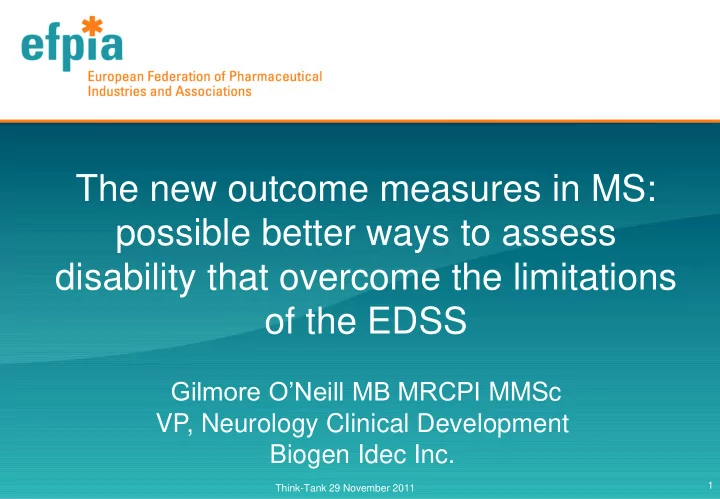

The new outcome measures in MS: possible better ways to assess disability that overcome the limitations of the EDSS Gilmore O’Neill MB MRCPI MMSc VP, Neurology Clinical Development Biogen Idec Inc. 1 Think-Tank 29 November 2011
AGENDA • What is the EDSS? • EDSS limitations • “Gaps in EDSS to be addressd ” • There have been and are multiple ongoing efforts to address the gaps in EDSS: – MSFC – EDSS-plus – Freedom from disease acitivity – MSOAC • Conclusion & Recommendations 2
EDSS 3 AMNOG webinar 04.10.11
EDSS • EDSS is a widely accepted measure of Physical Disability in MS • In SPMS, EDSS is not highly sensitive to change in disability, particularly at EDSS > 5.0 4
EDSS: Limitations • “The disadvantages and advantages of the EDSS in assessing disability in MS are well known .” – It is based on the standard neurological examination, which is inherently subjective “Guideline on clinical investigation of medicinal – As a result, the scale has poor reliability within and between raters products for the treatment of multiple sclerosis” (Doc. Ref. • Scores of 4 ・ 0 – 7 ・ 5 are based primarily on the distance the CPMP/EWP/561/98 Rev. 1 patient can walk and the need for an assistive device • EDSS captures MS related cognitive impairment poorly • EDSS is a non-linear ordinal scale: – populations show a bimodal distribution of EDSS categories, and the rate of progression through the scale by individual patients over time Jeffrey A Cohen, Stephen C varies as a function of baseline score Reingold, Chris H Polman, Jerry S Wolinsky, for the • CONCLUSION: Modification of the EDSS would be International Advisory Committee on Clinical Trials desirable to improve linearity of measurement, which would in Multiple Sclerosis facilitate statistical analysis and clinical interpretation. Disability measures in MS clinical Trials. Lancet Neurology 2012; 11: 467 5
EDSS GAPS TO ADDRESS 6 AMNOG webinar 04.10.11
Gaps in endpoints to address unmet need • SPMS/ PPMS: – Effect size – Variability in sensitivity • RRMS objectives: – Control of disease activity 7
EDSS “gaps to fill”: Effect size of T25FW > EDSS Timed 25 foot walk EDSS 8
EDSS “gaps to fill”: T25FW more sensitive to change in patient-subjects more disabled at baseline Diego Cadavid, Stephanie Jurgensen, Sophia Lee Effect of Natalizumab on ambulatory improvement in SP and Disabled RRMS PLoS ONE 8(1): e53297 9
EVOLVING EFFORTS TO ADDRESS GAPS IN DISABILITY ENDPOINTS 10 Think-Tank 29 November 2011
MSFC Rudick R, Antel J, Confavreux C, et al. Recommendations from the National Multiple Sclerosis Society Clinical Outcomes Assessment Task Force. Ann Neurol 1997; 42: 379 – 82. Cutter GR, Baier ML, Rudick RA, et al. Development of a multiple sclerosis functional composite as a clinical trial outcome measure. Brain 1999; 122: 871 – 82. 11
MSFC limitations • Abstract and dimensionless nature of the summary score. – Many clinicians are unfamiliar with Z scores – the reference population affects the absolute values for the components and their weighting • As a result, MSFC scores cannot be easily interpreted clinically or compared across studies • CONCLUSION: An alternative analytical approach is Jeffrey A Cohen, Stephen C to define worsening as a decrease in score by a Reingold, Chris H Polman, Jerry S Wolinsky, for the prespecified amount in any of the component tests, International Advisory Committee on Clinical Trials which can be determined reliably and has clinical in Multiple Sclerosis relevance (eg, 20%), and to show worsening in the Disability measures in MS clinical Trials. Lancet same component at two sequential time points. Neurology 2012; 11: 467 12
Composite endpoint “EDSS plus” Combined endpoint (“EDSS Plus”) enables more sensitive detection of change in disability across EDSS range 13
“Freedom from Disease Activity”: Remission Endpoint Clinical and Radiological Composite: (no relapses, no progression of disability [sustained for 12 weeks], no gadolinium-enhanced lesions, and no new or enlarging T2-hyperintense lesions) Eva Havrdova, Steven Galetta, Michael Hutchinson, Dusan Stefoski, Gavin Giovannoni, Stuart Cook, Kottil Rammohan, Peter Rieckmann, Per David Bates, Chris H Polman, Paul W O’Connor, Gavin Giovannoni, J Soelberg Sørensen, Patrick Vermersch, Anthony Hamlett, Vissia Viglietta, Theodore Phillips, Fred D Lublin, Amy Pace, Richard Kim, Robert Hyde Steven Greenberg Effect of natalizumab on clinical and radiological disease Sustained disease-activity-free status in patients with activity in multiple sclerosis: a retrospective analysis of the relapsing-remitting multiple sclerosis treated with Natalizumab Safety and Effi cacy in Relapsing-Remitting cladribine tablets in the CLARITY study: a post-hoc and Multiple Sclerosis (AFFIRM) study subgroup analysis Lancet Neurol 2009; 8: 254 – 60 Lancet Neurol 2009; 8: 254 – 60 14
MSOAC Project Mission • Develop and support adoption of a multi-dimensional clinical outcome assessment tool, and obtain regulatory qualification for use as a primary or secondary endpoint in MS clinical trials. • The qualified methodology will measure neuroperformance and will be sensitive to limitations in daily living activities of patients affected by MS. Standardized CDISC MS Data MS Data Standards Legacy Aggregated MS Data MS Research Database Prepare & Submit Legacy Qualification MS Data Dossier Prepare & Submit Regulatory Documents Legacy MS Data Research / Statistical Analysis ….. Year 1 Year 2 Year 3 Current Position Multiple Sclerosis Outcome Assessments Consortium (MSOAC)
Conclusion • EDSS has been successfully used in the development and approval of a number of DMTs for RMS. – Nevertheless: EDSS has limitations • Actively evolving landscape is developing alternative/ novel outcome measures that might address identified gaps in disability endpoints: – in use in clinical trials • e.g. “EDSS plus” in SPMS Tysabri – under development • e.g. MSOAC collaboration 16
Recommendations • Agree that the guidance continuing to acknowledge the limitations of EDSS • Guidance should be open to novel endpoints of disability as primary efficacy outcomes • Guidance should ensure that novel outcome measures that fill existing recognized gaps in disability endpoints will not be rejected (over the lifetime of this document) 17
Recommend
More recommend